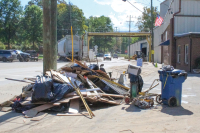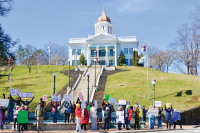Cherokee hospital uses art to build community
When the Eastern Band of Cherokee Indians took over the Cherokee Indian Hospital from the Indian Health Service in 2002, the hospital’s administrators faced a challenge.
They wanted the hospital to feel like it belonged to the community, but they inherited a building that was far from welcoming.
“People wanted to be surrounded by Cherokee things,” said Jody Adams, the hospital’s director of community relations.
The hospital’s motto “Ni-hi tsa-tse-li” means “It belongs to you,” but there was nothing Cherokee about the white walls and clinical feel inside the hospital.
Adams formed a culture committee comprised of hospital staff and community elders and turned to the Cherokee Preservation Foundation for grant funding. Susan Jenkins, executive director of the Foundation, said the hospital’s makeover mission was exactly the kind of project the organization wants to fund.
“When they came to us, we thought it was a great fit, because they would have to work with the elders and the community and reach out to the local artists,” Jenkins said.
Related Items
The Foundation has contributed $20,000 per year to the hospital’s cultural makeover. Adams has overseen the projects, which partner with local artists to transform the interior spaces of the building into venues for displaying Cherokee art and culture.
When you walk in the main entrance, you can see the impact right away. A large mural in the waiting area combines Cherokee words written in the syllabary and their English translations. The television monitors in the waiting rooms show cultural documentaries instead of Fox News or CNN.
Look deeper in the hospital and you’ll see walls filled with the portraits of elders, or hand-painted with animal tracks.
Jenkins has been impressed with the hospital’s transformation. An enrolled member of the Choctaw tribe of Oklahoma, she has seen enough of IHS hospitals to know the difference.
“Now when you go in there you get a sense that ‘Oh gee, this is my place,’” Jenkins said.
Room by room, Adams’ committee has targeted rooms for overhauls. They started with the hospice room, a place where patients come to live their last days in comfort surrounded by family. Then they found an artist to design a traditional Road to Soco Mountain pattern, and they filled a hallway with it.
The waiting area to the dental clinic has a wall-sized mural of a mountain stream. Another room shows the process of making river cane baskets.
“One of the things we wanted to do with every room is teach something,” Adams said.
Adams said the latest project is to transform the hospital’s inpatient rooms.
“Most of the inpatient rooms still have that IHS feel,” Adams said. “The research shows the rooms are a factor in the healing process.”
Adams wanted new ideas for the rooms, so she turned to Western Carolina University’s interior design program for a partnership.
“I wanted new ideas. I wanted to show the nurses and the providers that there are a lot of options. We don’t have to be a facility full of white rooms,” Adams said.
Candace Roberts, a WCU interior design professor, along with her students created a portfolio of potential design schemes for the inpatient rooms and along the way they met with elders to learn about the Cherokee culture. The first transformed inpatient room was finished last week, but Adams said the transformation of the hospital will continue.
Promoting culture
Filling the otherwise institutional walls of the Cherokee hospital with cultural themes is just one of many projects funded by the Cherokee Preservation Foundation. The Foundation was formed in 2000 with a mission to preserve Cherokee culture, enhance economic development and improve the environment using casino revenue. Since 2002, the Foundation has given out more than $47 million in grants throughout the region, which in turn have generated more than $100 million when combined with matching money.









